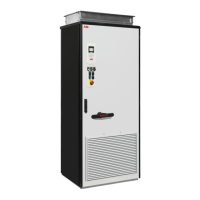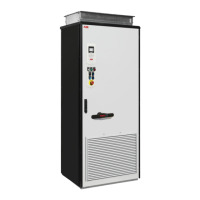310 Parameters
37.17 ULC frequency
table point 2
Defines the 2nd frequency point on the X-axis of the user load
curve.
25.0 Hz
0.0 … 500.0 Hz Frequency. 1 = 1 Hz
37.18 ULC frequency
table point 3
Defines the 3rd frequency point on the X-axis of the user load
curve.
43.0 Hz
0.0 … 500.0 Hz Frequency. 1 = 1 Hz
37.19 ULC frequency
table point 4
Defines the 4th frequency point on the X-axis of the user load
curve.
50.0 Hz
0.0 … 500.0 Hz Frequency. 1 = 1 Hz
37.20 ULC frequency
table point 5
Defines the 5th frequency point on the X-axis of the user load
curve.
60.0 Hz
0.0 … 500.0 Hz Frequency. 1 = 1 Hz
37.21 ULC underload
point 1
Defines the 1st point of the underload curve.
Each point of the underload curve must have a lower value
than the corresponding overload point.
10.0%
0.0 … 1600.0% Underload point. 1 = 1%
37.22 ULC underload
point 2
Defines the 2nd point of the underload curve. 15.0%
0.0 … 1600.0% Underload point. 1 = 1%
37.23 ULC underload
point 3
Defines the 3rd point of the underload curve. 25.0%
0.0 … 1600.0% Underload point. 1 = 1%
37.24 ULC underload
point 4
Defines the 4th point of the underload curve. 30.0%
0.0 … 1600.0% Underload point. 1 = 1%
37.25 ULC underload
point 5
Defines the 5th point of the underload curve. 30.0%
0.0 … 1600.0% Underload point. 1 = 1%
37.31 ULC overload point
1
Defines the 1st point of the overload curve.
Each point of the overload curve must have a higher value
than the corresponding underload point.
300.0%
0.0 … 1600.0% Overload point. 1 = 1%
37.32 ULC overload point
2
Defines the 2nd point of the overload curve. 300.0%
0.0 … 1600.0% Overload point. 1 = 1%
37.33 ULC overload point
3
Defines the 3rd point of the overload curve. 300.0%
0.0 … 1600.0% Overload point. 1 = 1%
37.34 ULC overload point
4
Defines the 4th point of the overload curve. 300.0%
0.0 … 1600.0% Overload point. 1 = 1%
37.35 ULC overload point
5
Defines the 5th point of the overload curve. 300.0%
0.0 … 1600.0% Overload point. 1 = 1%
No. Name/Value Description Def/FbEq16

